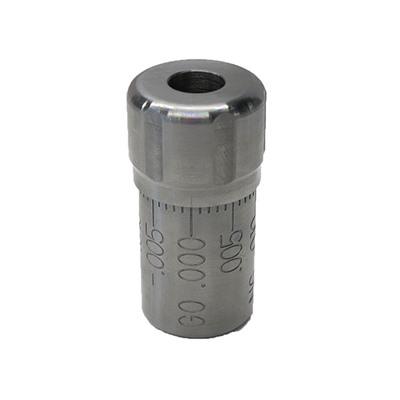Thanks for all the replies guys! I use a RCBS Rockchucker press. With the shell holder making contact with the die it is giving me a shoulder setback of .007. Should I adjust for .004 as bigedp51 suggested? That seems like the best option. Thanks again guys.
I'm using Redding competition shell holders when sizing my "fired" Lake City 5.56 cases in my AR15. I use the plus +.004 shell holder for approximately .003 shoulder bump. If using the standard shell holder with die making hard contact with the shell holder I would have .007 shoulder bump. And remember shoulder bump can vary from die to die, my Lee die can bump the case shoulder back .009 vs .007 for my RCBS small base die.
As stated above it can take several case firings before the case conforms to actual chamber dimensions. I was surprised this week I took some loaded ammunition sized with a small base die for my AR15 rifle and fired them in my new Ruger .223 Ranch Rifle. The fired cases were .004 to .006 shorter than their sized headspace length after firing. Meaning they ended up shorter with the primer protruding. But the load was a starting load of 24.0 grains of H4895 and a 69 grain Sierra bullet. Meaning the chamber pressure was not high enough to make the case stretch to meet the bolt face.
Bottom line, cases sized with a small base die will be shorter than cases sized with a standard die. And again the only reason I use a small base die is on bulk once fired Lake City brass I buy fired in a multitude of chambers. And then after firing in my chamber I use a standard .223 full length die
You can take a new case or a full length resized case and place a fired spent primer in the primer pocket just using your fingers. Then chamber the empty case and let the bolt face seat the primer the rest of the way. Then measure the case length with a comparator gauge and have a very good idea of actual chamber headspace length.
You can look at item "C" below and see the AR15s chamber is .002 larger than a standard .223 chamber. Meaning the standard .223 sizing die could be considered a small base die due to the larger diameter chamber.
I'm loading for three AR15 rifles, so I use a JP Enterprise chamber gauge that is cut with a finish chamber reamer and smaller in diameter the Wilson or Dillon case gauges. I use this gauge for a plop test to ensure the case diameter has been reduced enough to chamber in any AR15 rifle.
Below the fired cases when placed in base first will drop in further into the Wilson and Dillon case gauges. Meaning the Wilson and Dillon gauges have a larger body diameter and are primarily checking shoulder location. And the red JP Enterprise is cut smaller in diameter and how I check for case body brass spring back after sizing once fired brass. And yes sometimes once fired brass sized with a standard die will not drop all the way into the JP Enterprise gauge. "BUT" brass sized with a standard die in your chamber should chamber. But you should check the fired case diameter and a sized case diameter because dies do vary in size.





